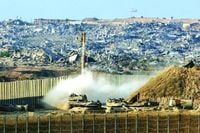In a high-profile meeting at the White House on August 27, 2025, former British prime minister Tony Blair joined U.S. President Donald Trump and a select group of advisers to discuss the future of Gaza once the ongoing war comes to a close. According to multiple media outlets, including France 24, The Guardian, and Axios, the gathering included Trump’s son-in-law and former senior adviser Jared Kushner, as well as Trump’s Middle East envoy Steve Witkoff. The session, described by a senior White House official as "simply a policy meeting," aimed to tackle the many thorny issues surrounding Gaza’s post-war governance, humanitarian relief, and regional security.
Tony Blair, aged 72, is no stranger to the complexities of Middle Eastern diplomacy. After stepping down as prime minister in 2007, Blair served as the Middle East envoy for the so-called Quartet—a group comprised of the UN, US, EU, and Russia—until 2015. The Quartet was originally established in 2002 to facilitate a two-state solution, but as The Guardian noted, it has become largely dormant, undermined by geopolitical rifts such as Brexit, Russia’s international isolation, and the Trump administration’s skepticism toward the United Nations.
Blair’s presence in Washington underscores both his enduring influence and the urgency of the current crisis. As France 24 reported, the White House meeting addressed a broad array of topics: escalating food aid deliveries to Gaza, the ongoing hostage crisis, and the highly contentious matter of what comes next for the war-torn territory. The official line from the Trump administration is that the U.S. is putting together a "very comprehensive" plan for "the day after" the war ends.
Steve Witkoff, Trump’s Middle East envoy, previewed the meeting in an interview with Fox News on August 26, stating: “We’re going to settle this one way or another, certainly before the end of this year.” He emphasized the breadth and intention of the U.S. plan, saying, “It’s a very comprehensive plan we’re putting together on the next day that I think many people are going to see how robust it is and how well-meaning it is, and it reflects President Trump’s humanitarian motives here.”
Yet, as of now, the details of the proposals under discussion remain tightly under wraps. The White House offered only a broad statement: “President Trump has been clear that he wants the war to end, and he wants peace and prosperity for everyone in the region.” This sentiment, while hopeful, stands in stark contrast to the grim realities on the ground.
Recent days have seen a sharp escalation in violence and humanitarian suffering. On August 27, Israeli and U.S. officials met in Washington as Israel’s military warned that the evacuation of Gaza City was “inevitable” ahead of a new offensive. That same day, a double strike on Gaza’s Nasser Hospital killed 22 people, including journalists and medics, according to health officials cited by France 24. Meanwhile, Gaza health authorities reported that ten Palestinians, including two children, had died of starvation in the previous 24 hours. Since the war began on October 7, 2023, at least 313 people—including 119 children—have died from hunger, and more than 62,000 Palestinians have been killed, with the territory now in the grip of famine.
International condemnation has mounted. Pope Leo XIV, speaking before thousands at the Vatican, demanded that Israel halt its “collective punishment” of Gaza’s population. He called for a permanent ceasefire, the safe entry of humanitarian aid, and full respect for humanitarian law. The pope’s remarks were met with repeated applause as he referenced the “prohibition of collective punishment, indiscriminate use of force and the forced displacement of the population.”
On the diplomatic front, U.S. Secretary of State Marco Rubio held talks with Israeli Foreign Minister Gideon Sa’ar in Washington. When pressed by reporters about the possibility of a future Palestinian state, Sa’ar was unequivocal: “It will not exist.” This hardline stance, reported by The Guardian and other outlets, further complicates any vision for a peaceful, post-war Gaza.
The situation on the ground continues to deteriorate. Overnight before August 27, Israeli tanks rolled into the outskirts of Gaza City, destroying homes and displacing residents. Tanks shelled the Ebad al-Rahman neighborhood on the city’s northern edge, causing injuries as Israeli forces sought to clear a path ahead of a widely anticipated offensive. In the previous 24 hours alone, Israeli strikes and gunfire killed at least 76 people across Gaza, according to local health authorities.
President Trump, who during last year’s campaign promised a quick end to the Gaza war, has found a resolution elusive seven months into his second term. The initial ceasefire at the start of his presidency lasted only two months, ending when Israeli strikes killed around 400 Palestinians on March 18. Since then, images of starving children and devastated neighborhoods have shocked the world and fed growing criticism of Israel’s actions from both international observers and some U.S. allies.
At the policy meeting, Trump, Blair, Kushner, and their advisers reportedly discussed not only immediate humanitarian needs but also the broader political future of Gaza. While the White House has yet to disclose specifics, the emphasis on a “robust” and “well-meaning” plan suggests a desire to balance security concerns, humanitarian imperatives, and diplomatic realities. Whether such a plan can satisfy all stakeholders—especially given Israel’s rejection of a Palestinian state and the Quartet’s diminished influence—remains to be seen.
For Blair, the meeting represented another chapter in a long career spent navigating the labyrinth of Middle Eastern politics. A trusted Washington ally since the days of the Iraq invasion, he has consistently advocated for a negotiated solution, even as the prospects for a two-state outcome have faded. His return to the diplomatic stage, alongside figures like Kushner and Witkoff, highlights both the enduring challenges and the persistent hope for a better future in Gaza.
As the world watches and waits, the fate of Gaza hangs in the balance. The coming months will test the resolve of leaders in Washington, Jerusalem, and beyond to deliver not just plans, but real relief and a path toward peace for a region long beset by conflict and despair.


